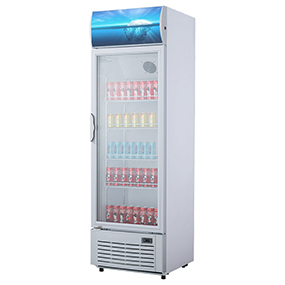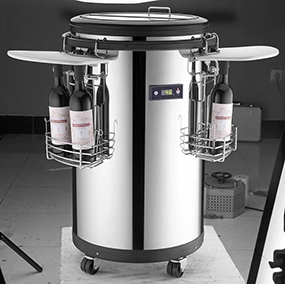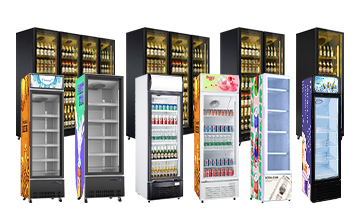What is the principle of defrosting commercial refrigerators?
Sep 03,2024 - 16:02 Reading:685
In the commercial field, commercial refrigerators play a crucial role. They provide a suitable storage environment for various items such as food and medicines. The disadvantage is that after a period of use, frost often appears in the refrigerator, and at this time, defrosting operations are required. So, what is the principle of defrosting commercial refrigerators? Today, let's explore it.

First of all, we need to understand why refrigerators frost. When the moist air inside the refrigerator encounters the surface of the evaporator with a lower temperature, it will condense into frost. This is because the moisture in the air will change from a gaseous state to a solid state at low temperatures. As time goes by, the frost layer will become thicker and thicker, which will not only affect the refrigeration effect of the refrigerator but also increase energy consumption.
There are mainly the following principles for defrosting commercial refrigerators:
1.Natural defrosting
This method uses the increase in temperature inside the refrigerator after it is shut down to make the frost layer melt naturally. When the temperature inside the refrigerator rises to a certain extent, the frost layer will gradually turn into water and then be discharged from the refrigerator through the drainage hole. The advantage of natural defrosting is that it is simple and does not require additional energy consumption. However, the disadvantage is that the defrosting time is relatively long and may affect the use of the refrigerator.
2.Heating defrosting
Heating defrosting is a relatively common defrosting method in commercial refrigerators at present. It installs heating wires or heating tubes around the evaporator. When defrosting is needed, the heating device is started to increase the temperature on the surface of the evaporator, so that the frost layer melts. Heating defrosting is relatively fast and can complete the defrosting operation in a relatively short time. However, this method requires a certain amount of electrical energy consumption.
3.Hot gas defrosting
Hot gas defrosting uses the high-temperature and high-pressure gas discharged from the compressor and introduces it into the evaporator through a pipeline to increase the temperature on the surface of the evaporator and melt the frost layer. The advantage of this defrosting method is that it has a good defrosting effect and can utilize the waste heat discharged by the compressor to save energy. However, the hot gas defrosting system is relatively complex and has a higher cost.
4.Automatic defrosting
Now many commercial refrigerators are equipped with an automatic defrosting system. This system detects parameters such as the thickness and temperature of the frost layer inside the refrigerator through sensors. When certain conditions are met, the defrosting program is automatically started. The automatic defrosting system can achieve unattended operation and improve the convenience and reliability of using the refrigerator.
Through the above four aspects of analysis, the defrosting principles of commercial refrigerators mainly include natural defrosting, heating defrosting, hot gas defrosting, and automatic defrosting. Different defrosting methods have their own advantages and disadvantages. Users can choose a suitable commercial refrigerator according to their actual needs. When using a commercial refrigerator, we should also pay attention to regular defrosting operations to ensure the normal operation and service life of the refrigerator.
Popular item
-

Mega Top Pizza Prep Table Refrigerator with Pan Rail Top 60″ Inch
(5) -

Cheapest Smallest Fridge Countertop with Glass Door 4 Gallon SC15
(5) -

Cheapest Smallest Cooler Countertop with Glass Door 6 Gallon SC25
(5) -

Cheapest Smallest Refrigerator Countertop with Glass Door 6 Gallon SC35
(5) -

Top Freezer Display Fridge Freezer with Glass Door 55L 1.9 Cu Ft
(5) -

Big Glass Door Kitchen Freezer Side by Side with Auto Defrost 1000 Liters
(5) -

Grocery Store Swing Door Visi Merchandiser with Clear Front
(5) -

Supermarket Horizontal Open Swing Door Merchandiser Refrigerator
(5) -

Vertical Upright Fridge Built in Freezer Fridge 200L 7 Cu Ft
(5) -

Glass Swing Door Cooler Ventilated Cooling 0–10℃ 268 Litre
(5) -

Small Display Merchandiser Cooler with Clear Front 335 Litres
(5) -

Mini Cooler Fridge with Self-Closing Door 105 Litres
(5) -

Small Refrigerator with Slimline Design with Glass Door 135L
(5) -

Small Beverage Cooler with Transparent Door 145 Litres
(5) -

Small Drink Fridge with Glass Door and Led Lights 350L
(5) -

Small Drink Fridge with Glass Door 0–10℃ 310 Liters
(5) -

Stainless Steel Barrel Cooler Mini Bar Fridge for Wine and Beverage
(5) -

Round Pepsi Cooler Freestanding with Top Open Cover
(5) -

Mini Round Topo Chico Cooler Small Barrel Shape Upright
(5) -

Outdoor Mobile Round coke Cooler for Party event Marketing
(5)

































